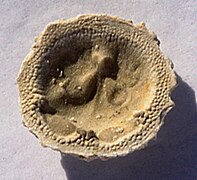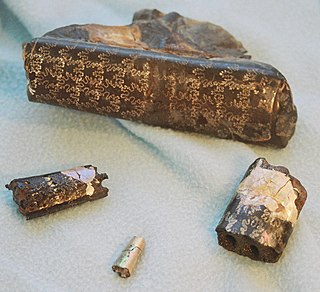
Baculites is an extinct genus of cephalopods with a nearly straight shell, included in the heteromorph ammonites. The genus, which lived worldwide throughout most of the Late Cretaceous, and which briefly survived the K-Pg mass extinction event, was named by Lamarck in 1799.

The Maastrichtian is, in the ICS geologic timescale, the latest age of the Late Cretaceous Epoch or Upper Cretaceous Series, the Cretaceous Period or System, and of the Mesozoic Era or Erathem. It spanned the interval from 72.1 to 66 million years ago. The Maastrichtian was preceded by the Campanian and succeeded by the Danian.
The Campanian is the fifth of six ages of the Late Cretaceous Epoch on the geologic timescale of the International Commission on Stratigraphy (ICS). In chronostratigraphy, it is the fifth of six stages in the Upper Cretaceous Series. Campanian spans the time from 83.6 to 72.1 million years ago. It is preceded by the Santonian and it is followed by the Maastrichtian.
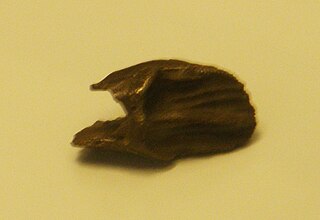
Craspedodon is an extinct genus of ornithischian dinosaur, possibly a ceratopsian. It lived during the Late Cretaceous, in what is now Belgium. Only a few teeth have ever been found, which were described as similar to those of Iguanodon. Craspedodon lonzeensis, described by Louis Dollo in 1883, is the type species, although it is considered a nomen dubium since it is based on fragmentary material. It was long thought to be an iguanodontian, but a 2007 restudy suggested that it was actually a neoceratopsian, perhaps closer to Ceratopsoidea than Protoceratopsidae. If the reidentification is correct, Craspedodon would be the first neoceratopsian known from Europe.

The Halisaurinae are a subfamily of mosasaurs, a group of Late Cretaceous marine lizards. They were small to medium-sized, ranging from just under 3 meters in Eonatator sternbergi to as much as 8 or 9 meters in Pluridens serpentis. They tended to have relatively slender jaws and small, numerous teeth, suggesting a diet of small fish and other prey. Although the skeleton is primitive compared to other Mosasauridae in many respects, halisaurines had the distinctive hypocercal tail of other mosasaurids suggesting good swimming ability, and they persisted alongside other mosasaurs until the end of the Cretaceous. The earliest known remains of halisaurines occur in rocks of Santonian age and the subfamily persists until the latest Maastrichtian. Halisaurines are known from North and South America, Europe, Asia and Africa, indicating a more or less global distribution in the Late Cretaceous. Four genera are currently recognized: Eonatator, Halisaurus, Phosphorosaurus and Pluridens.
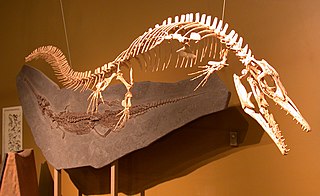
Halisaurus is an extinct genus of marine reptile belonging to the mosasaur family. The holotype, consisting of an angular and a basicranium fragment discovered near Hornerstown, New Jersey, already revealed a relatively unique combination of features and prompted a new genus to be described. It was named by Othniel Charles Marsh in 1869 and means "ocean lizard". It was renamed by Marsh to Baptosaurus in 1870, since he believed the name to already be preoccupied by the fish Halosaurus. According to modern rules, a difference of a letter is enough and the substitute name is unneeded, making "Baptosaurus" a junior synonym.

Hainosaurus is an extinct genus of marine reptiles belonging to the mosasaur family. It is one of the largest mosasaurs, though its size has been revised more than once. At first it was estimated to be 17 metres (56 ft), and the largest mosasaurid. During the 1990s, its size was revised to 15 metres (49 ft) long; more recently, Johan Lindgren estimated that it reached lengths of up to 12.2 metres (40 ft). It was one of the top marine predators of the Late Cretaceous. Like other giant mosasaurs, this giant predator preyed on turtles, plesiosaurs, pterosaurs, cephalopods, sharks, fish, and smaller mosasaurs.
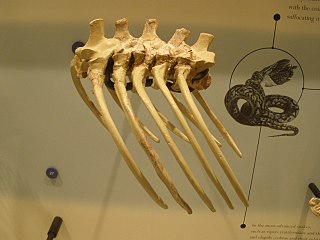
Madtsoiidae is an extinct family of mostly Gondwanan snakes with a fossil record extending from early Cenomanian to late Pleistocene strata located in South America, Africa, India, Australia and Southern Europe. Madtsoiidae include very primitive snakes, which like extant boas and pythons would likely dispatch their prey by constriction. Genera include Gigantophis, one of the longest snakes known, at an estimated 10.7 metres (35 ft), and the Australian Wonambi and Yurlunggur. As a grouping of basal forms the composition and even the validity of Madtsoiidae is in a state of flux as new pertinent finds are described.

Madtsoia is an extinct genus of madtsoiid snakes. It is known from the Eocene of Argentina, the Paleocene of Brazil, the Late Cretaceous (Campanian) of Spain, the Late Cretaceous of India, and the Late Cretaceous (Maastrichtian) of Madagascar and the Coniacian of Niger. Recovered vertebrae of M. pisdurensis are 1.83 centimetres (0.72 in) long and 4.35 centimetres (1.71 in) tall) and pertain to a snake that was approximately 5 metres (16 ft) long.
Kingena is an extinct genus of primarily Cretaceous-aged brachiopods of the family Kingenidae whose fossils are found in marine strata of Antarctica, Europe, and New Zealand. Early Paleocene-aged fossils from Denmark represent the youngest species.

Terebratula is a modern genus of brachiopods with a fossil record dating back to the Late Devonian. These brachiopods are stationary epifaunal suspension feeders and have a worldwide distribution.
Goniosaurus is an extinct genus of plesiosaur from the Late Cretaceous of the Nekum Chalk, in Netherlands. The only species so far described, G. binskhorsti is represented only by an isolated, compressed and slender tooth described by Hermman Meyer and a referred tooth and a cervical vertebra that shows that was an elasmosaurid, as many others Late Cretaceous plesiosaurs from Europe.
Denazinosuchus is a genus of goniopholidid mesoeucrocodylian. Its fossils have been recovered from the Upper Cretaceous Fruitland Formation and Kirtland Formation of the San Juan Basin, New Mexico. It is the most abundant and readily identifiable mesoeucrocodylian of the San Juan Basin, mostly due to its distinctive subrectangular, flattened, and sparsely pitted bony armor. It was first described in 1932 by Carl Wiman on the basis of a skull as a species of Goniopholis, G. kirtlandicus. Spencer G. Lucas and Robert M. Sullivan redescribed the species in 2003 and gave it its own genus, Denazinosuchus. To date, Denazinosuchus is only known from skull material, armor, and a thigh bone.
Aemula is an extinct genus of brachiopods that lived during the Cretaceous period. The pedunculate brachiopod species Aemula inusitata had lived on the bodies of larger animals which served for enough feeding surface, since no large attachment sites were available on the Maastrichtian chalk of the sea floor. It was a very small animal, having a maximum length of 7 mm, and is believed to have been short lived as interpreted from its growth lines.

Phosphorosaurus is an extinct genus of marine lizard belonging to the mosasaur family. Phosphorosaurus is classified within the Halisaurinae subfamily alongside the genera Pluridens, Eonatator and Halisaurus.
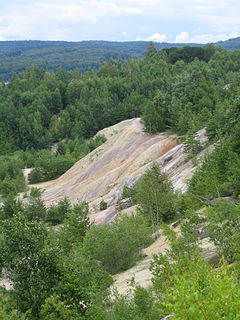
The Kristianstad Basin is a Cretaceous-age structural basin and geological formation in northeastern Skåne, the southernmost province of Sweden. The basin extends from Hanöbukten, a bay in the Baltic Sea, in the east to the town of Hässleholm in the west and ends with the two horsts Linderödsåsen and Nävlingeåsen in the south. The basin's northern boundary is more diffuse and there are several outlying portions of Cretaceous-age sediments. During the Cretaceous, the region was a shallow subtropical to temperate inland sea and archipelago.

The Kristianstad Basin is a Cretaceous-age structural basin and geological formation in northeastern Skåne, the southernmost province of Sweden. The sediments in the basin preserves a wide assortment of taxa represented in its fossil record, including the only non-avian dinosaur fossils in Sweden and one of the world's most diverse mosasaur faunas.

Gypsonictops is an extinct genus of leptictidan mammals of the monotypic family Gypsonictopidae, which was described in 1927 by George Gaylord Simpson. Species in this genus were small mammals and the first representatives of the order Leptictida, that appeared during the Upper Cretaceous.
Kookne is a prehistoric bird genus from the Late Cretaceous. Known from a coracoid, the remains of the only known species Kookne yeutensis were found in rocks from the Late Cretaceous (Maastrichtian) Chorrillo Formation of Santa Cruz, Argentina.


